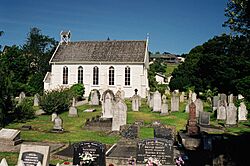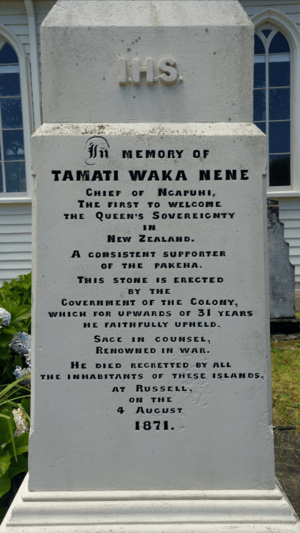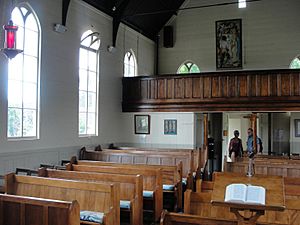Christ Church, Russell facts for kids
Quick facts for kids Christ Church |
|
|---|---|
|
Māori: Te Whare Karakia o Kororareka
|
|

Christ Church in Russell, with its historic graveyard, in 2001
|
|
| 35°15′47.6″S 174°07′24.8″E / 35.263222°S 174.123556°E | |
| Country | New Zealand |
| Denomination | Anglican |
| History | |
| Status | Church |
| Dedicated | c. 1870s |
| Architecture | |
| Functional status | Active |
| Architectural type | Church |
| Completed | 1835 |
Christ Church (also known as Māori: Te Whare Karakia o Kororareka in Māori) is the oldest church still standing in New Zealand. It is located in the village of Russell.
This Anglican church was built in 1835. Gilbert Mair oversaw its construction, with help from Charles Baker. When it first opened, services were held in both English and Māori. Sometimes, the church was even used as the local courthouse.
Christ Church is a very important historical building. Heritage New Zealand officially recognized it on November 24, 1983. It was given a Category I listing, which means it is of special historical importance.
Contents
A Look Back: The 1800s
In the early 1800s, Russell was known as Kororareka. It was a busy port where whalers would stop for safety. The land for the church was bought in 1834 from local chiefs. They agreed to sell it on one condition: both Māori and Pākehā (non-Māori) would have the same right to be buried in the church's graveyard.
Famous Visitors and Early Days
Even the famous scientist Charles Darwin helped pay for the church's construction. Darwin visited Russell in 1835. He thought the town was a bit wild, but he was very impressed by the nearly finished church. He called it "a bold experiment." Darwin, Captain Fitzroy, and other officers from the ship HMS Beagle all contributed money to build the church.
The church was built in 1835 with a simple design and a hipped roof. In the beginning, missionaries had to row across the harbor from Paihia to lead services. The very first service was held on January 3, 1836, by William Williams. During this time, services were held in both English and Māori. The church was also sometimes used as the local courthouse.
A Place of Important Decisions
On January 30, 1840, Captain William Hobson held an important meeting at the church. Both Māori and Pākehā leaders were there. Hobson announced that New Zealand would be governed through New South Wales. He also said he would be the Lieutenant Governor of New Zealand. Other important discussions about the Treaty of Waitangi happened across the harbor in Waitangi a week later.
Damage and Repairs
The church was damaged during the Battle of Kororareka in 1845. It was hit by musket and cannonballs. Tāmati Wāka Nene, a Māori chief who fought alongside the British in that battle, is buried in the church graveyard. In the early 1870s, the church was given its current name. A belfry (a tower for bells) was also added around this time.
Christ Church in the 1900s
In the early 1900s, vicars (church leaders) from Kawakawa served Christ Church. From 1953 onwards, vicars from Kerikeri took over. In 1963, Queen Elizabeth II and Prince Philip visited the church. Later, in 1986, Prime Minister David Lange and Sir Paul Reeves attended the church's 150th anniversary celebration.
The church was officially recognized by the New Zealand Historic Places Trust (now called Heritage New Zealand) on November 24, 1983. It received a Category I listing, marking it as a place of great historical importance.
Christ Church Today
In 2000, the church was carefully restored. Today, it is a popular place for tourists to visit. Christ Church is still used every week for Anglican worship, with services held each Sunday at 10:30 AM. Some services are also held in Te Reo Māori. The church is a special place for weddings, funerals, and other important events. Many believe it is the oldest building in New Zealand that is still used for its original purpose.



